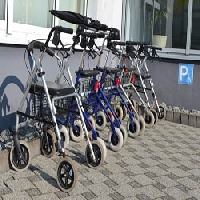
Using a senior walker with a seat is perfect for balance and endurance
Senior walkers with a seat are commonly called ?rollators.’ These walkers have four wheels and a seat and may have other features, such as brakes and a basket. One of the primary benefits of this type of walker is the fact that it works as well outdoors as it does inside. Many styles of rollators fold for easy storage or to fit in the trunk of a car.
Who should use a walker with a seat?
Anyone who needs a walker to help with balance without having to lean heavily upon it is a candidate for a rollator. People who have problems with endurance will find the seat particularly helpful, as it gives them a place to rest without having to search for seating. The optional bin is great for carrying items without having to hang a bag on an arm, which could pull a person off-balance.
Using a rollator walker
When you first get your rollator, adjust the handlebar height to a level that is comfortable for you. Tighten the adjusters to lock the bars in place and you?re good to get rolling.
~
Here?s how to take your first steps, along with using the seat.
- From a seated position, place your hands on the handlebar grips. Make sure the wheel brakes are locked so the walker can?t roll away from you.
- Stand up and look at your foot position. Your toes or mid-foot will usually be in line with the rear wheels.
- Unlock the brakes and take a few normal steps. Practice not hunching down over the walker or pushing it too far ahead so that it gets away from you. If it?s feeling very awkward, adjust your stride. One idea is to begin with shorter steps until you are used to the walker. The more you walk, the easier it will get.
- To turn around, use smaller steps to make efficient use of space. If you?re used to driving, think of this similarly to the turning radius of your car.
- To use the seat, make sure the brakes are locked. Use the bars for balance, turn around and sit on the seat portion of the walker. To stand, reverse the procedure.
Useful Features
There are many options to choose from when it comes to rolling walkers with seats. Larger wheels make it easier to move over uneven ground or through deeper pile carpeting. People without a lot of strength may find light-weight rollators the best choice for them, while others may like the extra feeling of stability from a heavier model.
Look at the type of brakes on the unit, too. For people with arthritis or limited hand strength, choose a brake style that is easy to both squeeze and lock into place. For comfort, opt for the padded seat. Sure, you could use a pillow, but it could slide off and become a tripping hazard. Some models feature pads on the front brace of the walker ? it becomes the seat back and is more comfortable.
Sometimes you can swap out the baskets, which is handy if you have quite a few things to carry from one place to another. If you have to bring along oxygen tanks, some companies offer accessories that keep the tanks attached to the bottom part of the walker. This way, the rollator isn?t top heavy, which could make it prone to tipping over. You can even get lights to attach to the frame. Some are motion activated so you don?t have to worry about fumbling for a switch or finding the button in the dark.
Know that it will take some time to get comfortable using a walker. Those who were very independent are often the most resistant to accepting help or are self-conscious about appearing weak. To help with this situation, focus on all the positive benefits of using the rollator. Highlight that it can help prevent falls and that it?s a tool to make their life a little better or easier. Explain that it?s important to use a walker when needed, especially when recommended by a doctor or physical therapist.
If you are the caregiver, be patient. Give the time and space needed for people to adjust to the idea of using a walker and accepting the equipment.
